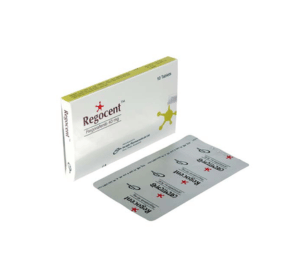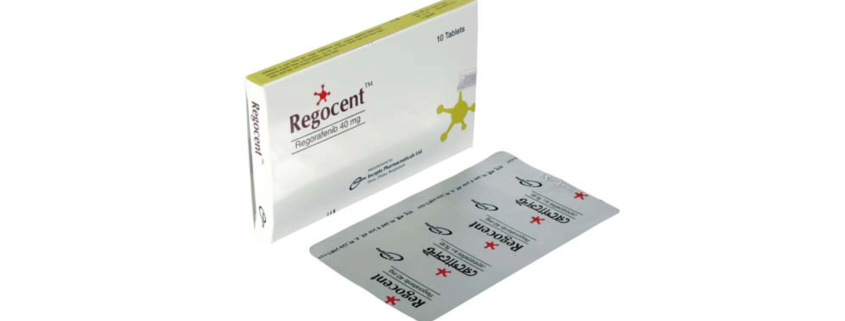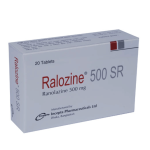Regocent(Regorafenib)

Therapeutic Group: Kinase inhibitor
Presentation
Regocent : Each tablet contains Regorafenib Monohydrate INN eq. to Regorafenib 40 mg.
Description
Regorafenib is a kinase inhibitor and it inhibits multiple membrane-bound and intracellular kinases involved in normal cellular functions and in pathologic processes such as oncogenesis, tumor angiogenesis, and maintenance of the tumor microenvironment. Regorafenib or its major human active metabolites M-2 and M-5 inhibits the activity of RET, VEGFR1, VEGFR2, VEGFR3, KIT, PDGFR-alpha, PDGFR-beta, FGFR1, FGFR2, TIE2, DDR2, Trk2A, Eph2A, RAF-1, BRAF, BRAFV600E, SAPK2, PTK5, and Abl. Due to its inhibitory functions, regorafenib can inhibit the progression of certain solid tumors.
Indications
Regorafenib is a kinase inhibitor that is indicated:
• For the treatment of metastatic colorectal cancer (CRC) after disease progression on or intolerance to fluoropyrimidine-based chemotherapy, anti-VEGF therapy and anti-EGFR therapy.
• For the treatment of unresectable or metastatic gastrointestinal stromal tumours (GIST) after disease progression on or intolerance to prior treatment with imatinib and sunitinib.
• For the treatment of hepatocellular carcinoma (HCC) in patients who have been previously treated with sorafenib
Dosage & Administration
• Metastatic colorectal cancer (CRC): 160 mg orally, once daily for the first 21 days of each 28-day cycle.
• Gastrointestinal stromal tumours (GIST): 160 mg orally, once daily for the first 21 days of each 28-day cycle.
• Hepatocellular carcinoma (HCC): 160 mg orally, once daily for the first 21 days of each 28-day cycle.
Side Effects
The most common side effects (≥30%) are asthenia/fatigue, decreased appetite and food intake, hand-foot skin reaction (HFSR) [palmar-plantar erythrodysesthesia (PPE)], diarrhea, mucositis, weight loss, infection, hypertension, and dysphonia.
Precautions
• Hemorrhage: Permanently discontinue regorafenib for severe or life-threatening hemorrhage. • Dermatological toxicity: Interrupt and then reduce or discontinue regorafenib depending on severity and persistence of dermatologic toxicity.
• Hypertension: Temporarily or permanently discontinue regorafenib for severe or uncontrolled hypertension.
• Cardiac ischemia and infarction: Withhold regorafenib for new or acute cardiac ischemia/infarction and resume only after resolution of acute ischemic events.
• Reversible Posterior Leukoencephalopathy Syndrome (RPLS): Discontinue regorafenib.
• Gastrointestinal perforation or fistulae: Discontinue regorafenib.
• Wound healing complications: Stop regorafenib before surgery. Discontinue in patients with wound dehiscence.
• Embryofetal toxicity: Can cause fetal harm. Advise women of potential risk to a fetus.
Use in Pregnancy & Lactation
Regorafenib is Pregnancy Category D. Based on its mechanism of action, Regorafenib can cause fetal harm when administered to a pregnant woman. There are no adequate and well-controlled studies with Regorafenib in pregnant women. Based on animal reproduction studies Regorafenib was seen to cause embryolethal and teratogenic defects and also increased the incidences of cardiovascular, genitourinary, and skeletal malformations in animals. Advice pregnant women or women with reproductive potential of the potential hazards of Regorafenib to the fetus. There is no information regarding the presence of regorafenib or its metabolites being excreted in human milk. Regorafenib and its metabolites were excreted in rat milk and because of the potential for serious adverse reactions in nursing infants from Regorafenib, a decision should be made whether to discontinue nursing or discontinue the drug, taking into account the importance of the drug to the mother.
Pediatric Use:
The safety and effectiveness of Regorafenib in pediatric patients less than 18 years have not been established.
Geriatric Use:
No overall differences in safety or effectiveness were observed between adult subjects and younger subjects.
Hepatic Impairment:
No clinically important differences in the mean exposure of regorafenib or the active metabolites M-2 and M-5 were observed in patients with hepatocellular carcinoma and mild (Child-Pugh A) or moderate (Child-Pugh B) hepatic impairment compared to patients with normal hepatic function. No dose adjustment is recommended in patients with mild or moderate hepatic impairment. Closely monitor patients with hepatic impairment for adverse reactions. Regorafenib is not recommended for use in patients with severe hepatic impairment (Child-Pugh Class C) as it has not been studied in this population.
Renal Impairment:
No dose adjustment is recommended for patients with mild renal impairment. Limited pharmacokinetic data are available from patients with moderate renal impairment (CLcr 30-59 mL/min/1.73m2). Regorafenib has not been studied in patients with severe renal impairment or end-stage renal disease.
Females and Males of Reproductive Potential:
Contraception: Use effective contraception during treatment and up to 2 months after completion of therapy. Infertility: There are no data on the effect of regorafenib on human fertility. Results from animal studies indicate that regorafenib can impair male and female fertility
Drug Interaction
• CYP3A4 Inhibitors: Avoid concomitant use of strong CYP3A4 inhibitors with Regorafenib.
• CYP3A4 Inducers: Avoid concomitant use of strong CYP3A4 inducers with Regorafenib.
Storage
Do not store above 30 0C. Keep away from light and out of the reach of children.
Commercial Pack
Regocent : Each box contains 1 blister strip of 10 tablets.



